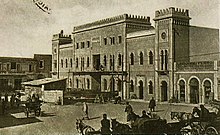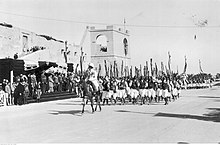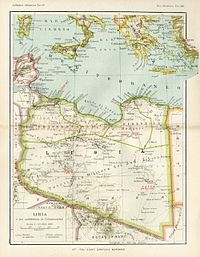|
Italian Cyrenaica
Italian Cyrenaica (Italian: Cirenaica Italiana; Arabic: برقة الايطالیة) was an Italian colony, located in present-day eastern Libya, that existed from 1911 to 1934. It was part of the territory conquered from the Ottoman Empire during the Italo-Turkish War of 1911,[1] alongside Italian Tripolitania. The territory of the two colonies was sometimes referred to as "Italian Libya" or Italian North Africa (Africa Settentrionale Italiana, or ASI). Both names were also used after their unification, with Italian Libya becoming the official name of the newly combined colony. In 1923, indigenous rebels associated with the Senussi Order organized the Libyan resistance movement against Italian settlement in Libya. The rebellion was put down by Italian forces in 1932, after the so-called "pacification campaign", which resulted in the deaths of a quarter of Cyrenaica's local population.[2] In 1934, it became part of Italian Libya. History Italian Cyrenaica and Italian Tripolitania were formed in 1911, during the conquest of Ottoman Tripolitania in the Italo-Turkish War.    In the 1920s, Cyrenaica was the scene of fighting between Italian colonial forces and Libyan rebels who were fighting for independence from colonial rule. In 1931, the rebel independence leader Omar Mukhtar was captured and executed. Fascist Italy maintained several concentration camps in Eastern Libya during the first phase of its occupation of that country. The colonial administration began in 1929 the nearly wholesale deportation of the people of the Jebel Akhdar to deny the rebels the support of the local population. The forced migration of more than 100,000 people ended in concentration camps in Suluq, El Magrun, Abyar and El Agheila where tens of thousands died in squalid conditions, mainly because of epidemics like the Spanish flu[citation needed]. The concentration camps were dismantled after 1934 when the fascist regime obtained full control of the area and started a policy of assimilation of the local Arab community. This policy was so successful that in 1940 there were two colonial military divisions of Arab Libyans. In the late 1930s, Cyrenaica was populated by more than 20,000 Italian colonists, mainly around the coast. As a consequence, there was a large economic development effort in the second half of the 1930s. Italy carried out massive investment in the infrastructure of Libya (the purpose was to develop the economy for the benefit of Greater Italy).[3] In Benghazi -for the first time in Cyrenaica's History- the first manufacturing installations were created: some industries were created in 'Bengasi italiana' in the early 1930s, that included salt processing, oil refining, food processing, cement manufacturing, tanning, brewing and sponge and tuna fishing. The port of Benghazi was enlarged and a modern Hospital. Also a new airport was built nearby was created. In 1934, Italian Cyrenaica and Italian Tripolitania became part of Italian Libya. DemographyIn the late 1930s, Cyrenaica was populated by more than 20,000 Italian colonists, mainly around the coast. As a consequence, there was a large economic development effort in the second half of the 1930s. Initially the Italian aim was to drive the local population to the marginal land in the interior and to resettle the Italian population in the most fertile lands of Libya, but since 1938 the new governor Italo Balbo changed this policy in order to get the approval from the native population.[3] The Italians did not provide the Libyans with adequate education until Balbo: the Italian population (about 15% of the total population) had 81 elementary schools in 1938, while the Libyans (more than 75% of total population) had 97.[3] In Cirenaica were founded -for the Italian colonists- the rural villages of Baracca, Maddalena, Oberdan, D’Annunzio and Battisti in 1938, successively Mameli and Filzi in 1939. For Libyan families (who contributed with many soldiers enrolled in the two Italian-Libyan Divisions: The 1st Libyan Division and 2nd Libyan Division were created in Cyrenaica in the villages of Gedida-Nuova, Nahida-Risorta, Zahra- Fiorita and el-Fager-Alba.  Infrastructure The Italians implemented major infrastructure projects in Italian Cyrenaica, mainly in the 1930s; the most important were the coastal road between Tripoli and Benghazi, the railways Benghazi-Barce and Benghazi-Soluch, and the enlargement of the Port of Benghazi. A group of villages with all the needed communications (and infrastructures) for Italians and Libyans were established in coastal Cyrenaica during the 1930s.[4] Main military and political developments
Notes
Bibliography
See alsoWikimedia Commons has media related to Italian Cyrenaica.
|
||||||||||||||||||||||||||||||||||||||||||||||||||||||||




